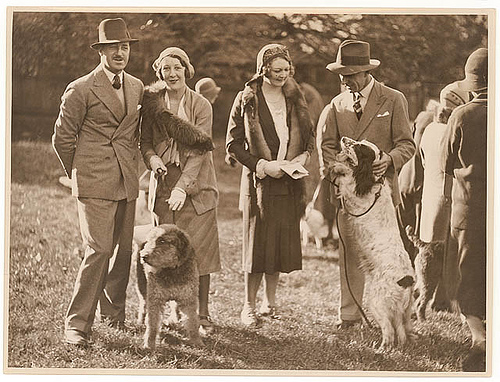
A well-mannered guard dog? Via Condé Nast Digital Archive.
Release the hounds! It’s that lofty defense aristocrats just can’t seem to outgrow. Last weekend, The New York Times reported that affluent families are relying increasingly on elite guard dogs to protect themselves and their lavish homes. Prices for these coveted animals, the article noted, can easily reach six figures, topping out at around $400,000 for special German shepherds with the right pedigree and natural instincts for the job. The sudden fascination with K-9 security is linked to the recent mission against Osama bin Laden, during which members of the navy’s black-ops force, SEAL Team Six, are believed to have fought alongside some sort of expertly trained dog combatant.
It doesn’t surprise me to learn that vastly rich households are willing to spend a small fortune on exceptional pets—especially ones associated with eliminating the world’s most formidable terrorist. Prosperous families already shell out millions each year on other prized animals, notably horses, which can cost the kind of money that only billionaires throw around. I’ve said it many times before in this blog, but I believe the point bears repeating—rich people are notoriously bad with intimacy, and the relationship they can form with a pet is often the most affectionate bond they ever know. For the patrician class, referring to dogs as “man’s best friend” is no exaggeration. (I’ll say it: dogs aren’t just their best friends—they’re often their only real friends.)
But what I find alarming about the desire to own a K-9 bodyguard, whatever the cost, isn’t that the urge stems from a failure of intimacy, but that rich people actually believe such an animal will protect them in the heat of a threatening moment. The idea that such people could hope to cohabitate with finely tuned guard dogs—to snuggle with them on the couch and feed them table scraps—without destroying their training in the process is preposterous. There’s a false perception held by many who have never witnessed the behavior of affluent families firsthand that everything runs pretty smoothly, and that an opulent lifestyle suggests a well-managed home. But that just isn’t true. The more stuff people have around them, the harder it is to care for it all, and the crazier the scene gets. Even at houses with huge numbers of staff, daily life is always completely screwed up just below the surface. Would not this chaotic environment impact the animal?
When I was a kid, one of my best friends had a pack of Great Danes. They were a perfect example of the guard-dog illusion. On an estate successfully designed to project an image of groomed affluence and social stature, the Great Danes were an imposing accent to the grounds. From a distance, they appeared terrifying to anyone who entered. They barked fiercely and did all the right things to look ferocious—but when you got up close, it was easy to see they couldn’t do anything beyond provoking fear. In essence, it’s a metaphor for these dogs outside the security industry, especially when they lack expert handlers. The K-9 security companies seem to realize this reality on some level, as well; while they mention in their ads that would-be assailants normally avoid homes where loud dogs are present, there is rarely, if ever, mention of examples of dogs’ actually fighting off criminals outside of a professional trainer’s care.
And who would be moved to chase down a masked robber from the comfy confines of a well-appointed family den?
The One Percent

